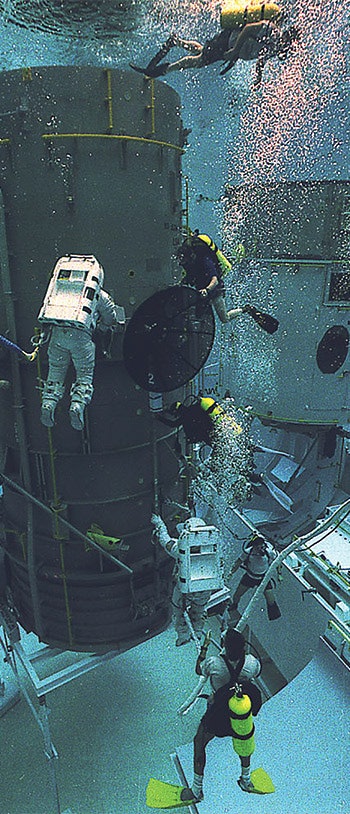
Before they can blast off into space, astronauts must complete a significant amount of their training underwater — in a 6.2 million gallon "swimming pool."
This happens at the Neutral Buoyancy Laboratory (NBL) in Texas, an enormous vessel used to prepare for space missions involving space walks. Astronauts spend up to seven hours at a time in the pool while they practice working on models of space vehicles like the ISS.
"[The NBL] is enormous," astronaut Nick Hague explained in NASA's podcast Curious Universe. "It's still not big enough to fit the entire space station in it, but it fits full-scale chunks of the station so that we can practice. And that's our training ground."
Neutral buoyancy is as close as humans can get to replicating the weightlessness of outer space here on Earth, so the NBL is used to develop space flight procedures, verify hardware compatibility and refine spacewalk procedures to ensure mission success. "Having this full-size mockup of the space station underwater allows us to essentially memorize where every handrail is, where every handhold is," says Hague. "And if I'm going to work in a particular location in orbit, it helps to have seen that and to understand that location on the ground."
Flotation devices and weights are combined in the pool to mimic the feeling of being in outer space, according to NASA. "We're constantly trying to balance out the weight of an object with its buoyancy so that things just float in front of you," says Hague.
RELATED: Astronaut Reunites with Swimming Pool After Year in Space

Underwater, astronauts get acquainted with working in the confines of a spacesuit, which can be difficult. They rehearse procedures with waterproof instructions attached to their arms, while a separate team watches every movement and monitors spacesuit pressure and temperatures.
"You have to learn how to use the spacesuit, because it's not like wearing clothes...it's constraining, and it limits some of the things you can do," says Hague. "It's fatiguing because it's stiff. It takes hours underwater, getting to know your spacesuit."
At 202 feet long and 102 feet wide, the pool is 40 feet deep, and its millions of gallons of water are turned over every 19.6 hours — which means it's got some big pumps. The water is chemically treated to control contaminant growth and minimize long-term corrosion. To minimize the potential effects of hypothermia on support divers, temperatures are controlled to 82-88 degrees Fahrenheit.
Hague recalls his first spacewalk: "Shortly after we went out the hatch, the sun set, and it got dark, and it felt exactly like I was in the pool. To the point where I remember having the thought go through my head, you know, 'Where are all the bubbles?'"
For the curious, a 360-degree tour of the NBL is available online.
This article first appeared in the May 2021 issue of AQUA Magazine — the top resource for retailers, builders and service pros in the pool and spa industry. Subscriptions to the print magazine are free to all industry professionals. Click here to subscribe.












































